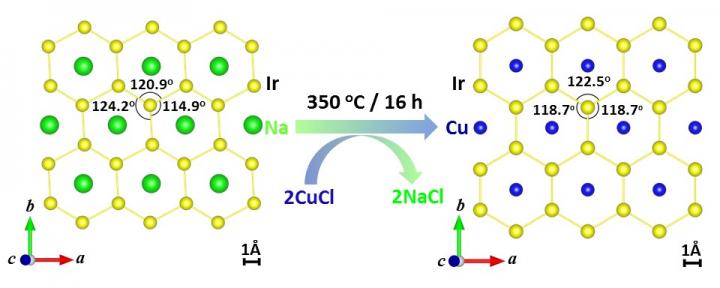A quantum spin liquid

Scientists from Boson College and Harvard turned to copper to create a first-of-its-kind iridate -- Cu2IrO3 -- where the natural magnetic order is disrupted, a state known as geometric frustration. Credit: Boston College
Researchers from Boston College and Harvard have created an elusive honeycomb-structured material capable of frustrating the magnetic properties within it in order to produce a chemical entity known as “spin liquid,” long theorized as a gateway to the free-flowing properties of quantum computing, according to a new report in the Journal of the American Chemical Society.
The first-of-its-kind copper iridate metal oxide – Cu2IrO3 – is one where the natural magnetic order is disrupted, a state known as geometric frustration, said Boston College Assistant Professor of Physics Fazel Tafti, a lead author of the study, titled Cu2IrO3: a new magnetically frustrated honeycomb iridate.
The copper iridate is an insulator – its electrons are immobilized in the solid – but they can still transport a magnetic moment known as “spin”. The transport of free spins in the material allows for a flow of quantum information.
The Kitaev model, proposed in 2006 by Cal Tech Professor of Physics Alexei Kitaev, states that a hexagonal honeycomb structure offered a promising route to geometric frustration and therefore, to quantum spin liquid.
Only two honeycomb lattice have been successfully developed in an attempt to fulfill Kitaev's model: a lithium iridate (Li2IrO3) and a sodium iridate (Na2IrO3). Yet both fell short of achieving an ideal spin liquid due to magnetic ordering, said Tafti, who co-authored the paper with Boston College post-doctoral researchers Mykola Abramchuk and Jason W. Krizan, BC Adjunct Professor of Chemistry and Director of Advanced Chemistry Laboratories Kenneth R. Metz, and Harvard's David C. Bell and Cigdem Ozsoy-Keskinbora.
Tafti and his team turned to copper due to its ideal atomic size, which is between lithium and sodium. Their studies in x-ray crystallography found subtle flaws in the honeycombs formed in the lithium and sodium iridates. The team swapped copper for sodium in what Tafti termed a relatively simple “exchange” reaction. The effort produced the first oxide of copper and iridium, Tafti said.
“Copper is ideally suited to the honeycomb structure,” said Tafti. “There is almost no distortion in the honeycomb structure.”
A decade after the original prediction of quantum spin liquid on a honeycomb lattice by Kitaev, the young team of scientists from Boston College succeeded in making a material that almost exactly corresponds to the Kitaev model, Tafti said.
Tafti's lab will pursue the “exchange” chemistry path to make new forms of honeycomb materials with more exotic magnetic properties, he said.
Media Contact
All latest news from the category: Physics and Astronomy
This area deals with the fundamental laws and building blocks of nature and how they interact, the properties and the behavior of matter, and research into space and time and their structures.
innovations-report provides in-depth reports and articles on subjects such as astrophysics, laser technologies, nuclear, quantum, particle and solid-state physics, nanotechnologies, planetary research and findings (Mars, Venus) and developments related to the Hubble Telescope.
Newest articles

A universal framework for spatial biology
SpatialData is a freely accessible tool to unify and integrate data from different omics technologies accounting for spatial information, which can provide holistic insights into health and disease. Biological processes…

How complex biological processes arise
A $20 million grant from the U.S. National Science Foundation (NSF) will support the establishment and operation of the National Synthesis Center for Emergence in the Molecular and Cellular Sciences (NCEMS) at…

Airborne single-photon lidar system achieves high-resolution 3D imaging
Compact, low-power system opens doors for photon-efficient drone and satellite-based environmental monitoring and mapping. Researchers have developed a compact and lightweight single-photon airborne lidar system that can acquire high-resolution 3D…





















